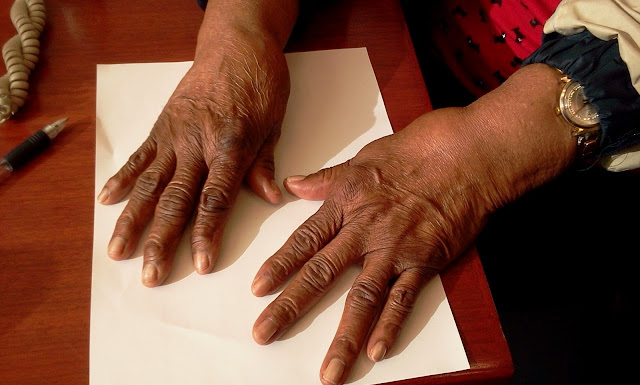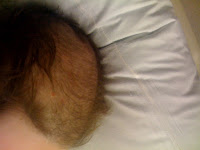December 25th, 2011 by Toni Brayer, M.D. in Health Tips
5 Comments »


Severe osteoarthritis of the hands
One of my patients came to see me today with severe right knee pain. This is not a new problem, and in fact, we have been dealing with flare ups of her osteoarthritis for years. It mainly affects her knees and hands and today her right knee was swollen and felt like the “bone was rubbing together” with each step. She could hardly walk because of the pain.
Osteoarthritis is also known as degenerative arthritis and it is one of the most common maladies of aging joints, affecting millions of people. The cartilage in joints wears down and inflammation causes the bones to build up spurs and small micro tears. It affects women more than men and the cause is unknown. There are likely genetic factors as it tends to run in families. Arthritis can occur in any joint but the most common are the fingers, wrists, hips, neck and spine and knees. Stiffness (especially in the morning) and pain are the main symptoms that limit mobility.
You can see Read more »
*This blog post was originally published at EverythingHealth*
September 20th, 2011 by RamonaBatesMD in Research
No Comments »

Somewhere along the line I learned to encourage women with a family history of breast cancer to begin getting mammograms at an age 10 years prior to when their mother was diagnosed and to encourage their daughters to begin getting mammograms at an age 10 years prior to when they themselves were ever diagnosed.
I learned this prior to the discovery of BRCA genes. It was a trend that had been noted among women with strong family histories. The new study (see full reference below) in the journal Cancer verifies that genetic breast cancers show up earlier in the next generation – on average by 8 years.
The study from MD Anderson looked at 2 generations of families with the BRCA gene to assess the age at diagnosis. Using the pool of 132 BRCA-positive women with breast cancer who participated in the high-risk protocol at The University of Texas MD Anderson Cancer Center (Gen 2), 106 women could be paired with a family member in the previous generation (Gen 1) who was diagnosed with a BRCA-related cancer (either breast cancer or ovarian cancer).
The median age of cancer diagnosis was Read more »
*This blog post was originally published at Suture for a Living*
April 11th, 2010 by Happy Hospitalist in Better Health Network, Health Tips, Humor, Opinion, True Stories
No Comments »

 A reader sent me this really sad story that got me thinking about hair restoration for women
A reader sent me this really sad story that got me thinking about hair restoration for women :
:
Happy, I wanted to share with you this picture of a woman who’s lost all hope. I saw her a few years back during my psychiatry rotation. As you can see, it looks like she’s going bald, but in fact, during her fits of rage and depression she’s actually pulling out her own hair. How sad is that? Just another example of what we docs take care of on a daily basis.
Man, that’s unbelievable. I don’t know much about classic female pattern baldness. From what I’ve read it’s usually a diffuse loss of hair everywhere or a central expansion of hair loss but rarely does it encompass the entire scalp. It’s usually caused by hormones, aging and genes. In advanced age, I’ve seen more than my fair share of elderly women who have more hair on their chin then they do on their head. Read more »
*This blog post was originally published at The Happy Hospitalist*
September 12th, 2009 by Kenneth Trofatter, M.D., Ph.D. in Better Health Network, Health Tips
No Comments »

Probably one of the most popular series I have written over the past few years is the one on recurrent early pregnancy loss. There is not a week that goes by that I still don’t get inquiries related to that subject, most accompanied by the pain, frustration, sense of loss, and feelings of hopelessness for future fertility. There are several points I always remind readers and patients about whenever I have the opportunity to discuss their concerns: 1) In most cases, the tincture of time alone offers the answer to their prayers; 2) If specific reasons for their losses are found or suspected, these can often be addressed medically and/or surgically; 3) If specific reasons cannot be identified, there are reasonable approaches to ‘empiric therapy’; and, 4) If these approaches fail, the science of assisted reproductive technology (ART) has advanced to the point that it can often overcome most obstacles that stand in the way of fertility.
The other points I always mention in response to the questions of “Why did this happen to me?”, “What did I do wrong to cause this?”, “What can I do to assure that it never happens to me again?, particularly to couples who have had their first or second miscarriage, or a sporadic miscarriage after successful pregnancies, are the following: 1) Miscarriages occur in 15-20% of all conceptions; 2) The MOST COMMON cause of early pregnancy losses are chromosomal abnormalities that occur by chance (except in the case of parental chromosomal rearrangements) and are not under any controllable influences; 3) It is unlikely that anything was “done” to cause the loss, although if there are such potential factors identified, the loss may provide an incentive to modify lifestyle prior to another pregnancy attempt to minimize their risks.
Recently, I received the query below from a woman who has had early pregnancy losses related to documented chromosomal abnormalities. Despite the other problems that have been identified which might contribute to reduced fertility in her case, these probably had no influence on her babies’ chromosomal abnormalities. But, they do give us the opportunity to briefly discuss the well-known observations that certain seemingly “unusual” chromosomal abnormalities (“unusual” in that they rarely or never result in a live born baby) actually contribute to a relatively high percentage of early pregnancy losses. Read more »
This post, Genetic Causes Of Early Pregnancy Loss, was originally published on
Healthine.com by Kenneth Trofatter, M.D., Ph.D..
March 12th, 2009 by Stacy Stryer, M.D. in Health Policy
No Comments »
By Stacy Beller Stryer, M.D.
I vividly remember my firsts in medical school – my first patient with cystic fibrosis who was so air hungry that he couldn’t even speak, my first teen who was constantly admitted to the hospital with an infection due to a genetic disorder that would eventually kill him, and my first 3 year-old patient with sickle cell anemia who almost died because her spleen decided to sequester many of her red cells. They were my firsts, but they certainly won’t be my lasts.
On March 9th, however, President Obama took a major step toward helping these children and so many others just like them. It gives me hope that someday there will be a few lasts. On Monday, he signed an executive order which relaxed restrictions on embryonic stem cell research and allowed federal funding for such projects. This is big. It reverses an almost 8 year policy that severely restricted such funding and the ability to use embryonic stem cells.
Embryonic stem cell research will open up the doors for potential cures and treatments for diseases such as Parkinson’s and Alzheimer’s, and for traumatic injuries, such as those that involve the brain and spinal cord. But the potential benefit of stem cells isn’t just for adults. Discoveries from embryonic stem cell research could save many lives and significantly reduce the suffering of children with a whole variety of diseases. Many medical centers, such as the University of Cincinnati, are or will soon be greatly expanding their stem cell research programs because of this policy change.
Why are embryonic stem cells so important for research? These cells are truly amazing because they have the ability to turn into any other cell in the body, such as blood cells, nerve cells, islet cells (which make insulin in the pancreas), or even entire organs. Plus, these cells can continue to duplicate, or make more of themselves, which is wonderful for both research and eventual treatment. Think about a newborn, that starts out as a single cell which then continues to replicate and differentiate until it becomes a fetus. It is truly a miracle and is the reason embryonic stem cells are so important.
Researchers at the University of Cincinnati want, through new research, to successfully treat fatal and other serious genetic disorders. Other medical centers will use embryonic stem cells to search for treatments for illnesses such as cancer, cystic fibrosis, diabetes, muscular dystrophy, and traumatic injury. The list goes on and on. Results will not occur overnight. It will be a long, expensive time intensive process. Through this process, researchers hope to learn how cells differentiate into specific types of cells and how genes turn certain cells on and off. The ultimate goal is to successfully repair or even replace ineffective, damaged and abnormal cells.
Some people are against the use of embryonic stem cells in research and treatment because they believe that, even though it can save lives, it also ends a life. This is an issue everybody has to think about on a personal and individual level. Currently, federal guidelines require embryo stem cells to come from extra embryos that were made when a couple underwent in vitro fertilization but were not used and, if not used for research, would simply be thrown away.






 A reader sent me this really sad story that got me thinking about
A reader sent me this really sad story that got me thinking about 








